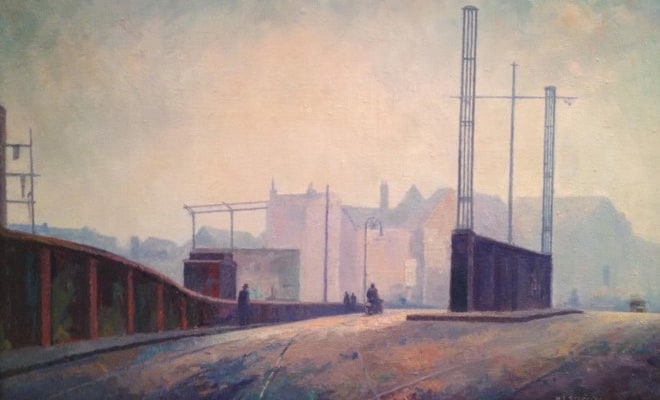Bow is located in East London, within the borough of Tower Hamlets. While often confused with the famous “Bow Bells” of St Mary-le-Bow in the City, Bow itself has a rich and distinct past worth exploring.
Dating back to the 11th century, the history of Bow begins as a modest settlement that grew into a bustling hub by the 17th century. It became known for cattle trading and the production of Bow Porcelain — a delicate blue-and-white ceramic made using cattle bones and clay. The Bow China Works remained one of the UK’s most notable porcelain producers until the 1770s.
By the Victorian era, Bow had become a centre of activism and women’s rights. Sylvia Pankhurst’s East London Federation of Suffragettes was based here, campaigning for better living conditions. The area also saw the famous Match Girls’ Strike at the Bryant and May factory in the 1880s – a key moment in the fight for workers’ rights.
Throughout the 19th and 20th centuries, Bow remained a hotbed of reform, home to influential figures like William Morris, Annie Besant, George Lansbury and more – all championing change, equality, and community spirit.
Today, Bow continues to carry that legacy, blending history, resilience and creativity. It’s a neighbourhood shaped by activism and industry – and one well worth discovering.
Things to Do in Bow to Explore Its Rich History & Heritage
From major industrial upheavals to political rebellion, Bow’s rich history is woven into its streets — and much of it is still visible today. If you’re looking for things to do in Bow, these four historic landmarks tell the stories that helped shape the East End, from bold factory strikes to the lasting legacy of Roman roads.
The Bryant and May Factory & The Bow Quarter
A defining chapter in Bow’s story starts with the Bryant & May match factory — once one of East London’s largest employers and a major site in the history of workers’ rights. Though now transformed into a gated residential complex known as Bow Quarter, the building’s red-brick façade and clock tower remain — quietly preserving a powerful legacy.
In 1888, harsh working conditions at the factory sparked the Match Girls’ Strike, led by teenager Sarah Chapman and supported by activist Annie Besant. Workers were exposed to white phosphorus, a toxic chemical causing horrific side effects like “phossy jaw” — a painful, often fatal condition. Wages were low, punishments frequent, and conditions unrelenting. When the factory tried to silence dissent, over 1,400 women and girls walked out in protest.
After two weeks of relentless organising, the strikers won. Bryant & May agreed to improve working conditions, and the movement led to the formation of the Matchmakers’ Union — one of the UK’s first successful female-led unions.
Today , the factory and its legacy symbolise Bow’s long-standing tradition of activism, solidarity and change-making.
Address: Fairfield Road, Bow, London E3
St Mary-le-Bow Church
While not physically located in Bow, St Mary-le-Bow holds symbolic significance in the area’s identity. It’s the home of the legendary “Bow Bells,” which famously define a true Cockney: only those born within earshot are said to earn the title.
The church’s history is dramatic. Founded in the 11th century as the London seat of the Archbishop of Canterbury, it’s been destroyed and rebuilt several times — including after the Great Fire of 1666, when Sir Christopher Wren redesigned it. In its early life, it served as a place of refuge during the English Civil War and witnessed grim scenes during Mary I’s reign, when Protestant prisoners were burned nearby.
In 1882, during the unveiling of the statue of Prime Minister William Gladstone outside the church, a group of match girls from Bow slashed their own hands and smeared his outstretched bronze hand with blood — a chilling protest against the fact that their wages had been docked to fund the statue. It’s said that even today, sympathisers occasionally mark the statue in tribute to their defiance.
If you’re visiting the church, St Mary-le-Bow offers a peaceful retreat with public events, private hire, and a café in its atmospheric crypt — a quiet space where history still lingers.
Address: St Mary Le Bow Church, Cheapside, London EC2V 6AU
Three Mills Island
Tucked along the River Lea, Three Mills Island is one of the most atmospheric historic sites in East London — and one of the oldest surviving industrial centres in the UK. The area has been in use for centuries, dating back to its mention in the Domesday Book. Originally, this tidal mill complex served London’s growing population by grinding grain for bread, taking advantage of the river’s unique tides.
Over time, the site evolved with the city’s needs. During Elizabethan times, the mills ground gunpowder for the army, and by the 18th century, they were distilling alcohol on a large scale. The House Mill, built in 1776, remains the largest tidal mill in Britain. Its twin — the Clock Mill — was rebuilt after WWII bomb damage and still stands beside it.
Today, Three Mills is more than just a relic. It’s home to 3 Mills Studios, a thriving film and television hub that hosted rehearsals for the London 2012 Olympics opening ceremonies. The area is still open to visitors, offering a rare glimpse into London’s working past — and how it continues to adapt and evolve.
Address: Three Mill Lane, London E3 3DU
The Roman Road Market
Bow’s Roman Road has been a path through East London for centuries — quite literally. Thought to be part of the Roman Empire’s ancient Pye Road, the route once connected London to the east coast and beyond. Archaeological digs have uncovered layers of Roman-era construction beneath the road, offering glimpses of its long and layered history.
But Roman Road isn’t just a relic — it’s one of London’s oldest surviving street markets and a lively social hub that’s been serving locals for over 150 years. Today, it’s open every Tuesday, Thursday and Saturday, selling everything from fresh produce and clothing to vintage items and household goods.
The area is also dotted with independent shops, restaurants, and community hubs. Whether you’re grabbing pie and mash at G. Kelly’s, sipping coffee in a local café, or browsing East End fashion stalls, you’re walking streets that have seen millennia of life — and continue to thrive with East London’s signature energy and charm.
Address: 536 Roman Rd, Bow, London E3 5ES
Living in the Hidden Gem of Bow, East London
Bow combines rich heritage with a welcoming, residential feel — full of Victorian architecture, leafy parks and easy links to central London. Surrounded by green spaces and supported by a growing range of local amenities, it’s an ideal choice for anyone seeking a quieter corner of the city.
For those living or moving here, our nearby self storage facility in the area provides secure, modern storage to help you make the most of your space — whether you’re relocating, renovating or just looking to declutter.



